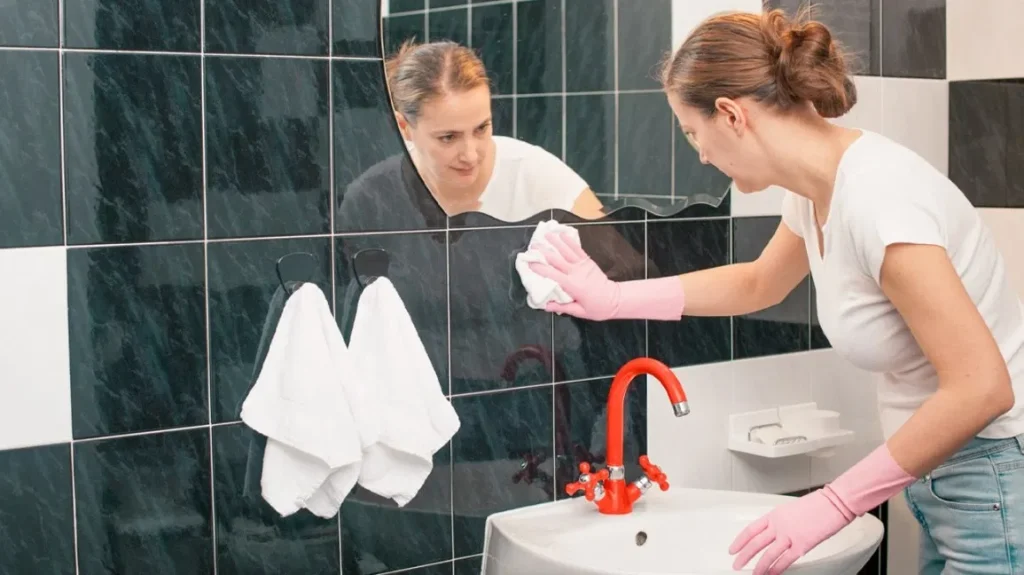Frequent exposure to moisture and humidity can lead to mold growth in bathrooms. Homeowners often ask, “how do I deal with mold in my bathroom?” This article addresses causes of mold growth, how to prevent it and what to do if you have mold in the bathroom.
Inspect Your Bathroom For Mold
Sometimes mold is obvious in a bathroom, such a black or green growth on tile grout. Other indications of mold include a damp musty smell, crumbling plaster, blistering paint or gaps in grout or caulk. Black spots on the ceiling are also usually mold.
Find Mold in Your Bathroom? What to Do Next
The first step in eliminating mold is locating the source of the water. Identify and repair plumbing leaks. Before attempting a cleanup, determine how severe the mold infestation is. The EPA recommends hiring professionals to clean a moldy area larger than 10 square feet. Let the pros handle mold remediation if you have asthma, are allergic to mold or are immunocompromised.
If you’re hiring a contractor, the EPA advises finding one like SERVPRO that specializes in removing mold. For example, SERVPRO uses a seven-step process to assess and contain the mold damage, and clean and restore your home.
There are a few pointers to keep in mind if you’re doing your own mold cleanup:
Wear protective gear
To avoid breathing mold spores wear an N-95 mask.Use rubber latex gloves like the ones found at easygloves to shield from any harmful chemicals and disinfectants. Wearing goggles will protect your eyes from mold spores.
Scrub hard surfaces
Clean hard surfaces with detergent and water and dry completely. Other effective mold cleaners are vinegar, Borax, or baking soda, mixed with water to form a paste.
Discard porous materials
When mold grows on porous materials, such as drywall or ceiling tiles, they need to be discarded. It’s almost impossible to completely remove mold from porous materials.
Don’t paint or caulk
Don’t paint or caulk moldy surfaces. Clean up surfaces and allow them to dry before painting.
Preventing Mold in Your Bathroom
Keeping your bathroom free of mold means avoiding excess moisture and humidity. Here are a few steps to take to prevent mold in your bathroom.
Use an exhaust fan
Keep the indoor humidity below 60% by using an exhaust fan when you take a bath or shower. The fan should be the proper size to remove water vapor from the room. CFM, or cubic feet per minute is the measurement for air movement. To calculate proper capacity for a bathroom fan, measure your bathroom. The ventilation rate should be one CFM per square foot. So a bathroom that is 7’ x 10’ requires a 70 CFM fan. For best results, run the fan at least 20 minutes after showering.
Frequently Wash Towels and Rugs
Make sure cloth bathroom accessories, like towels, rugs and shower curtains, dry thoroughly after use. Launder them weekly.
Avoid Product Puddles
Remove product bottles and bath loofahs from the shower when not in use. Water can puddle behind them and allow mold growth.
Squeegee the Shower
Keep a squeegee within reach and take a minute to squeegee the shower walls, and doors. Your shower doors will stay sparkling clean and you’ll instantly reduce moisture in the bathroom.
Use Mold-Killing Cleaners
Use all-purpose cleaners with mold-killing ingredients to prevent mold from taking hold in your bathroom. Open a window when using products with bleach because breathing the fumes can be harmful.
What to do When You Find Mold In Your Bathroom
Finding a little mold on the bathroom tile grout is probably a DIY job. But for a larger mold growth or one that involves replacing tile, flooring or drywall, call in experts. They will manage cleanup, repairs and take steps to prevent mold from spreading through your ventilation system. Some, like SERVPRO, even coordinate the claims process if needed. Whatever you choose, act fast to restore your bathroom to a clean and healthy condition.

